Table of contents
- Harley-Davidson Revolution Max engine New Harley engine in detail
- The performance data of the new engine
- Motor contributes
- The crankshaft
- Displacement and cylinder heads
- Dry sump lubrication
- Mass balancing V2 with crank pin offset
- Clutch and transmission
- Other cubic capacity class possible
- opinion poll
- Conclusion
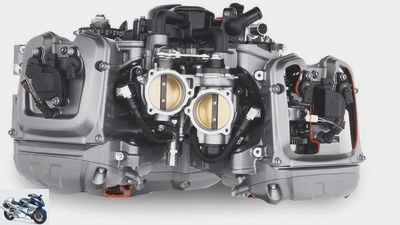
Harley-Davidson
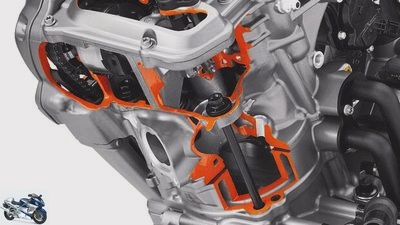



15th pictures

Harley-Davidson
1/15
Harley’s new dual-ignition engine is called Revolution Max.

Harley-Davidson
2/15
It has water cooling, a cylinder angle of 60 degrees and a crank pin offset of 30 degrees …

Harley-Davidson
3/15
… that results in a firing order like a 90 degree twin, with high mass balance. And: contrary to the air-cooled V-Twins, the engine is not like that “real V2” more.

Harley-Davidson
4/15
The cylinder heads each have two camshafts, variable valve timing and four valves that are filled with sodium for better cooling.

Harley-Davidson
5/15
The oil supply is ensured by dry sump lubrication with three pumps, the clutch has an anti-hopping function.

Harley-Davidson
6/15
The overhead camshafts drive the valves via rocker arms with hydraulic compensation. The silver box on the left is the variable valve adjustment. in between a small balancer shaft turns for support.

Harley-Davidson
7/15
The piston with its diameter of 105 millimeters creates such a large combustion chamber that H-D needs two spark plugs for optimal combustion.

Harley-Davidson
8/15
The engine has a sensor for each camshaft to control the variable timing. One of the two ignition coils is in the middle, the other on the left in the direction of travel.

Harley-Davidson
9/15
The valve covers are made of a light magnesium alloy, the primary drive covers are made of the same material.

Harley-Davidson
10/15
On the left in the direction of travel, the alternator sits on the output gear of the starter. One of the three oil pumps is driven by a chain. The oil nozzle seems to be in front of the alternator cover.

Harley-Davidson
11/15
The clutch is mechanically operated, the narrow gearbox has straight teeth, the gear shafts sit one above the other.

Harley-Davidson
12/15
The engine is also very narrow from the front. The alternator sits close to the housing, the starter is very deep inside.
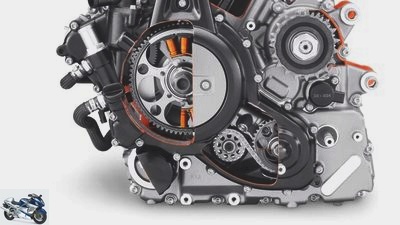
Harley-Davidson
13/15
In autumn 2018, in addition to the now official Pan America, three other studies with the new engine were shown: A flat tracker …
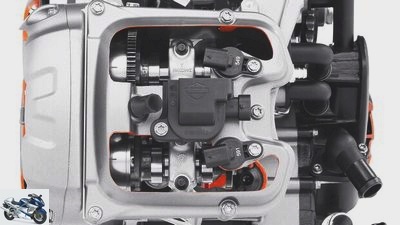
Harley-Davidson
14/15
… the Bronx or Streetfighter …
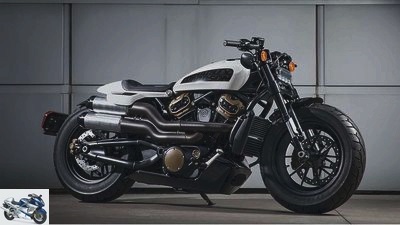
Harley-Davidson
15/15
… and of course the Custom 1250 as the successor to the Sportster.
counselor
technology & future
Harley-Davidson Revolution Max-Motor: New Harley-Twin in detail
Harley-Davidson Revolution Max engine
New Harley engine in detail
Since autumn 2018, the new Revolution Max engine from Harley-Davidson is no longer a secret. At that time it was presented as a liquid-cooled drive for the future models Pan America, Flattracker, Bronx and Custom 1250.
Jens Kratschmar
02/25/2021
The motor future of Harley-Davidson is with the official presentation of the Harley-Davidson Pan America 1250 now reality. Concrete data, background information and facts about the new, liquid-cooled V2 engine baptized Revolution Max make Harley-Davidson appear in a very modern light.
The performance data of the new engine
With the performance data of the new engine, Harley is definitely breaking new ground. No Harley was ever stronger or more revving at the factory. From its 1,247 cubic meters, the twin in the Pan America draws 152 hp at 8,750 revolutions and delivers a mighty 128 Nm at 6,750 revs.

Harley-Davidson
The cylinder heads each have two camshafts, variable valve timing, four valves, and the exhaust valves are filled with sodium for better cooling.
Motor contributes
For the first time in Harley’s history, the engine is designed to be load-bearing, so it contributes a lot to the rigidity of the entire motorcycle. The front part of the frame with the steering head extends over the two cylinder heads with a subframe for the tank and airbox and is screwed to it at six to eight points. A look between the two cylinders on the motorcycle reveals an X-brace. The rear frame and rocker arm are bolted to the rear cylinder head and the gearbox.
The crankshaft
Of course a V2. It has to be with Harley. The two cylinders are at an angle of 60 degrees to each other, but the pistons move at a 90 degree angle to each other and therefore fire irregularly. Harley has given the engine an additional crank pin offset of 30 degrees, which historically makes the engine a fake V2. This can be seen from the laterally offset cylinders. Classic Harley twins, i.e. real V2, have no offset, the cylinders are directly behind one another. The unique fork connecting rod of the air-cooled twins has no place in the new Revolution Max engine. The Japan twins of the 1980s and 1990s were also largely fake V2s.

Harley-Davidson
The cylinder angle of 60 degrees and the crank pin offset of 30 degrees result in a firing order like a 90 degree twin.
Displacement and cylinder heads
Forged light metal pistons with a diameter of 105 millimeters travel 72 millimeters through cylinders coated with nickel and silicon carbide. Together that results in a displacement of 1,247 cubic meters. The aluminum cylinder heads each have two camshafts, each of which actuates four valves via rocker arms. The valve train is maintenance-free thanks to hydraulic compensation of the valve clearance: completely Harley with hydraulic valve lifters. The milled piston crown allows a very high compression of 13.0: 1. This high working pressure and the resulting temperatures also explain the use of double ignition, as well as the filling of the exhaust valves as a heat exchanger: The valves are filled with sodium, which melts at 97 degrees and is thrown through the shaft with each valve stroke. Due to the high thermal conductivity of sodium, so much heat is transferred from the exhaust valve, which is subject to high thermal loads, into the cylinder head.
For better cylinder filling and torque curve in the lower range, the Revolution Max has a variable valve control for intake and exhaust valves. An electro-hydraulic phase adjuster – an electric motor that works with the pressure of the engine oil – turns the camshafts up to 40 degrees early or late: the valves open at other times during the rotation of the crankshaft. In this way, the advantages of little valve overlap for more torque and those of a lot of overlap to increase maximum performance can easily be combined. The system also functions as a decompression system when the engine is started.

Harley-Davidson
The piston with its diameter of 105 millimeters creates such a large combustion chamber that H-D needs two spark plugs for optimal combustion.
Dry sump lubrication
The oil supply in the Revolution Max engine is handled by dry sump lubrication. The oil reservoir is integrated into the engine housing under the moving parts of the crankshaft and gearbox and is supplied by three suction pumps. They suck that “Second hand” Drain the oil from the crankcase, the area around the alternator, and the clutch. The system enables a lower overall height of the engine, a better center of gravity, as well as a safe supply of oil, even when the motorcycle is leaned very high or when the motorcycle is lying. A heat exchanger in the cooling water circuit on the right-hand side of the engine is used to cool the oil.
The lubrication system has another special feature: the pump in the crankcase creates a negative pressure and thus enables a lower preload of the piston rings, which in turn results in less friction in the cylinder during the stroke. Harley’s almost 100 years of experience with dry sump lubrication have made a system possible that works with very little oil pressure (4.1 to 4.8 bar) and thus reduces power losses at high speeds: a high oil pressure at low speeds would be caused by high pump speeds continue to rise, which would result in an overpressure of oil in the bearings and thus a braking effect. Comparable to immersion in water.

Harley-Davidson
On the left in the direction of travel, the alternator sits on the output gear of the starter. One of the three oil pumps is driven by a chain. The oil nozzle seems to be in front of the alternator cover.
Mass balancing V2 with crank pin offset
The crank pin offset of 30 degrees plus the cylinder angle of 60 degrees results in an ignition angle of 90 degrees. As with modern row wins with a 270-degree crankshaft or the real 90-degree engines from Ducati, the result is very balanced inertia forces and order: the engine only vibrates a little. But especially at high speeds and due to the four overhead camshafts, such engines develop very fine vibrations, which Harley compensates for in the Revolution Max engine with a chain-driven balance shaft in the crankcase. To keep this shaft light and compact, another balancer shaft rotates in the cylinder head between the camshafts. A trick that KTM, among others, has already used on its enormously powerful single-cylinder 690 cc.
Clutch and transmission
The design of the engine, which is completely new for Harley, allows a very compact clutch-gear unit, which allows a very short primary drive via helical gears. As a reminder: The large air-cooled twins use a very long chain between the crankshaft and clutch, and even a wide toothed belt for conversions. With the Revolution Max, the speed is transmitted by a gear that is equipped with balancing springs to dampen the torque peaks of a big bang engine – which a 90-degree twin always is. This is not a technical revolution, but it shows the consistency with which Harley has developed this engine. The clutch, which is rather small in diameter, works with eight friction disks, reduces manual forces through torque support and also works as an anti-hopping clutch when downshifting thanks to the same system.

Harley-Davidson
The engine has a sensor for each camshaft to control the variable timing. One of the two ignition coils is in the middle, the other on the left in the direction of travel.
Other cubic capacity class possible
Time will tell to what extent this engine can be adapted for other displacement classes. On paper, reducing the bore from 105 to 92.8 millimeters would result in a displacement of 976 cc with the same stroke, not far from the rumored version with 975 cc, which is in the Streetfighter concept was presented. Respectful at a distance from the 1250, but powerful enough. Using the rule of three based on the output of the 1,247 cubic twin with 152 hp, 976 cubic with 119 hp would be good in the forage. Harley named 115 hp and 975 cc displacement for the Streetfighter at the time.
FunFact: A ratio of 93 to 65 millimeters results in a displacement of 883 cubic and which is very well known to sports drivers.
It will probably not be less, however, since the disadvantages of a V-engine will then come into play: high weight due to many duplicate components and the costs of manufacturing. Reasons why most other manufacturers in this class rely on in-line engines.
The calculation leads to the other extreme when the stroke is increased to 80 millimeters. That would result in a volume of almost 1,400 cubic meters and would reduce the possible speed to less than 8,000 tours through high mean piston speeds. There should be no advantage of a short-stroke engine here.
opinion poll
The future of Harley lies in the hands of the liquid-cooled V2?
Voted 820 times
Yes, this is the only way to continue.
No, the classic air-cooled V2 will continue to dominate.
Conclusion
The new Revolution Max is a modern V2 engine with contemporary technology, high power output and a liter output of 126 hp. Harley doesn’t have to hide with that.
But the engine also shows that the V2 is structurally complex. A large combustion chamber with high compression, for example, needs double ignition for optimal combustion.
Other cubic capacities are certain, no manufacturer in the world can afford just one engine. We will soon see the great guy Revolution Max again in another dimension.
Related articles
-
Harley-Davidson Sportster S: 122 hp, 15,500 euros
News 2022 New motorcycle items for 2022 Harley-Davidson 15th pictures Harley-Davidson 1/15 Harley is happily staying close to the custom concept. The new…
-
Technology: BMW S 1000 RR engine in detail
BMW 13th pictures Artist 1/13 The on-board tool kit of the BMW almost ties in with old traditions. With the help of the nine-part set you can strip the…
-
Harley-Davidson Pan America 1250: This is the Milwaukee Enduro
News 2022 New motorcycle items for 2022 Harley-Davidson 21 pictures Harley-Davidson 1/21 There’s the thing. Harley Davidson Pan America 1250….
-
Driving report Harley-Davidson Breakout
Photo: manufacturer 33 pictures manufacturer 1/33 Harley-Davidson Softail Breakout in the driving report. manufacturer 2/33 Harley-Davidson Softail…
-
Harley-Davidson Fat Boy for sale
Harley-Davidson counselor Used purchase Harley-Davidson Fat Boy for sale Harley-Davidson Fat Boy for sale The heavy hum The range of products on offer is…
-
Harley-Davidson Sportster S: comparison with Triumph, Indian, Honda
News 2022 New motorcycle items for 2022 Patrick Lang / manufacturer 12th pictures Harley-Davidson 1/12 Harley gives the new Sportster S clear features of…
-
Patent for Harley-Davidson with compressor
Harley-Davidson 9 pictures Harley-Davidson 1/9 Harley would build a compressor behind the engine on top of the gearbox. Harley-Davidson 2/9 The drive is…
-
Harley-Davidson 338R – Entry-level Harley for China is coming in 2020
New items 2020 Top topic Harley-Davidson 15th pictures Harley-Davidson 1/15 Harley-Davidson brings a new entry-level model. Harley-Davidson 2/15 Pictures…
-
Driving report Harley-Davidson Dyna Wide Glide
Ratering motorcycles Driving report Harley-Davidson Dyna Wide Glide Driving report Harley-Davidson Dyna Wide Glide Glide means The very well-stocked…
-
50 years of the Harley-Davidson Super Glide: The first custom bike ex works
Harley-Davidson 25th pictures Harley-Davidson 1/25 Super Glide from 1971 Harley-Davidson 2/25 Super Glide from 1971 Harley-Davidson 3/25 Super Glide from…